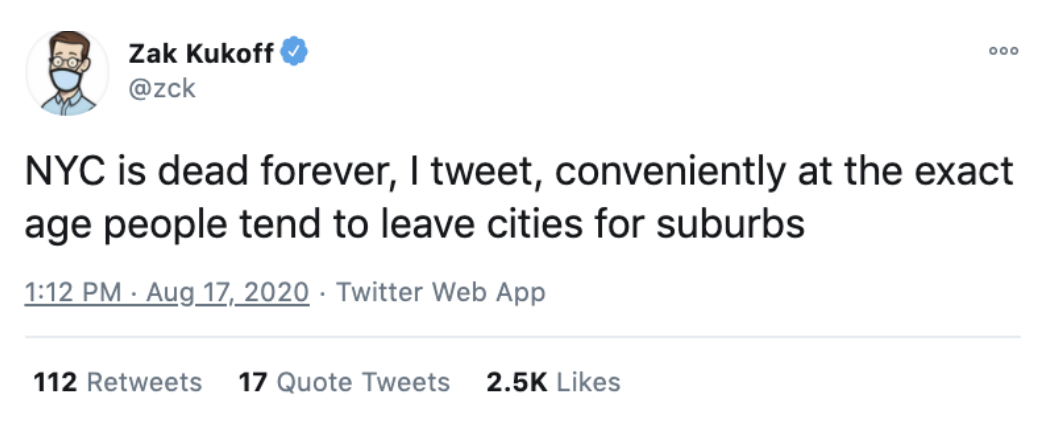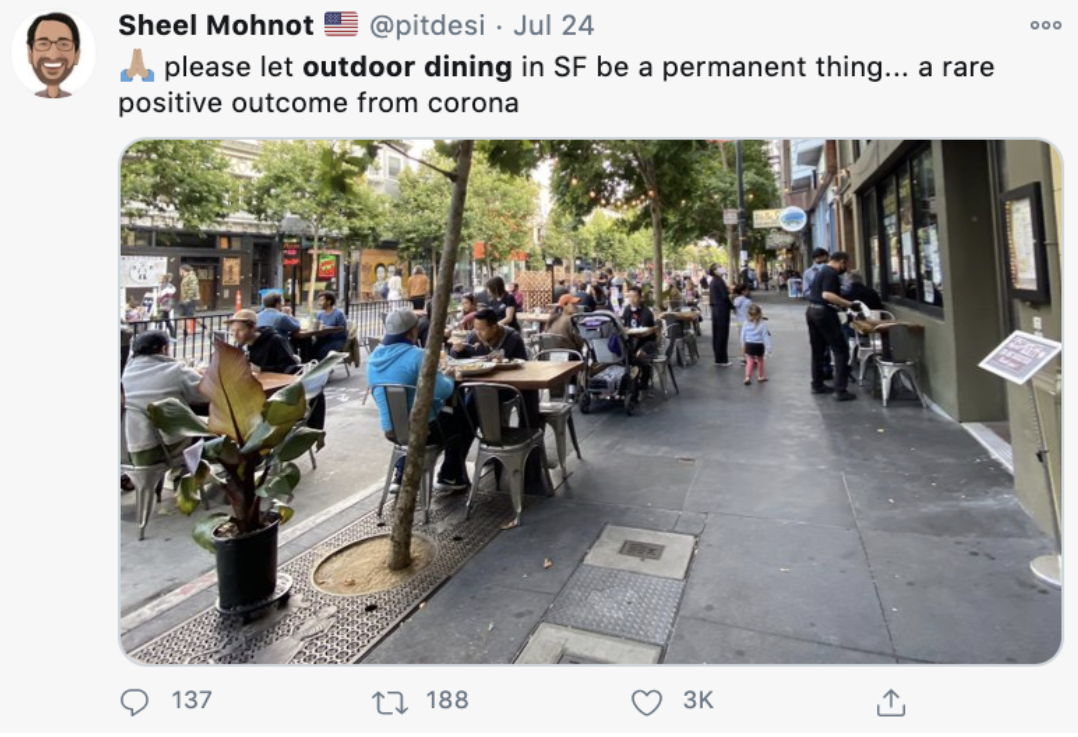
~10 min read.
The ‘death of cities’ is the start of a revival.
And why a man playing his saxophone to a turtle in NYC is one reason cities will never fade.
It’s going to get worse for cities before it gets better.
More businesses will close, evictions will take hold and city deficits will climb. More headlines will claim the “death of cities” is here. Outlets will cherrypick Instagram posts, TikToks and Tweets that show cities in chaos.


While there’s no doubt the future for cities looks disastrous now, it’s not a sign of death rather it’s the beginning of a revival. That’s what history points to.

As the wealthy flee, as they always do, they're going to be replaced by a wave of young, creative and hopeful 20-somethings. They'll take advantage of lower rents so they too can stumble upon a man playing a saxophone to a turtle.

I understand how ridiculous that sounds but cities have an energy, diversity, eclecticism and vibrancy that will never ‘die’ and no remote location or zoom party or workshop will replace it.
There’s a lot for them to revive though. The past few decades has led to some shit outcomes for cities; cars dominate roads, air quality is dismal, systemic inequality is rampant, government inaction is standard, the list goes on.
It may have taken decades to reverse some of these trends, but with the rate of change happening right now, it may just be a few years.
Reclaiming streets from car traffic.
The first silver lining of the pandemic was the shutdown of streets and turning them into walkable zones with outdoor dining. Many cities are considering never going back to a car dominated system, including two cities not known for enacting sweeping change.
In Paris 400 miles of bike lanes were recently installed and Mayor Anne Hidalgo has called returning to a car-dominated status quo "out of the question”.
Outdoor dining in New York City may be permanent in warmer months: “As we begin a long-term recovery, we’re proud to extend and expand this effort [outdoor dining] to keep New York City the most vibrant city in the world. It’s time for a new tradition,” Governor de Blasio said. This small act of closing streets isn’t small in impact.

Less toxic cars, more electric everything
With car traffic reduced and people wanting to avoid dense forms of transit like subways and buses the demand of e-bikes and scooters has increased 230% over the same period last year. No surprise here. The more interesting point is the behavior shift.

As a country we’ve largely associated freedom with a car and that’s finally changing. Young adults are now taking short and medium trips via e-bike, scooter, bike, or even, yes, walking. This means less noise pollution, air pollution, congestion and more disposable dollars to spend in cities.
Taras Kravtchouk, CEO of Tarform, an electric mobility upstart goes further.


Could you see electric motorcycles with matte green algae paint, a seat made of pineapple leather and flax seed paneling ripping through cities soon? Taras and his team are already producing them in the Brooklyn Navy Yard.
Healthy options grow but need to broaden
The pandemic made us all uniquely aware of where our food comes from hyper aware of our health. In a time when many restaurants are going out of business it’s interesting to see that many of the new pop-ups are vegan.
We’re also seen a boom in urban farming. Creatively utilizing concrete zones into green zones. The reliance on long distant supply chains has come into question. Some have predicted that 10% of our food will be grown in cities in the not so distant future. But there is room for improvement in cities.


We’re actually seeing a decline in healthy food options available in already underserved neighborhoods creating even larger healthy food deserts in cities. Jon Gray, co-founder of Ghetto Gastro points out -
Organizations like Growing Home and entrepreneurs like Ghetto Gastro are stepping up to help these neighborhoods have better access to healthy food but there’s far more systemic change needed to happen to address the size of the challenge.

A stronger sense of community and equality
There’s hope to be had that this pandemic and social justice will actually bring city residents closer together to take on equality in meaningful ways. Carol Coletta, President of the, Memphis River Parks Partnership said:
In New York City we’re already seeing residents come together to support social justice and systemic change in record numbers. With the exposure has come an outpouring of civic action, reflection, and debate, from widespread and largely peaceful protests to mobilization for reforms. It is far too early to tell, but there is a greater chance that the process of recovery will usher in a period of reforms that will make the region a healthier, fairer, and more just place to live. - RPA. And we’re going to need communities to step up together to solve for the elephant in the room.
Vacancies, creative use and blue-sky thinking.
Walking down any major city street it's hard to miss the quantity of “for lease” signs. Every week there seems to be a headline of a company shutting down a city office. For cities this is going to cause a monolithic shortage in income, so they’ll be best served reducing zoning restrictions and encouraging creative use of these spaces.


There was a taste of this just prior to the pandemic. Canal Street in New York City was being taking vacant storefront and turning it into a walkable arts district. A district for new ideas, new voices and raising awareness on important issues. I am hopeful this type of renaissance can happen throughout the city with a conflation of lower rents, government incentives for new businesses and youthful optimism.
The ending with a caveat for the naysayers
Clearly this is a hopeful, potentially naive, opinion.
This list of challenges in front of cities is paralyzing and businesses and residents need government relief now. It’s overwhelmingly depressing. So I’d rather put forward a hopeful, future facing view that looks to opportunities to use this moment as one to better cities for decades to come. If any place can overcome the odds, it’s in cities where you can stumble across a man playing his saxophone to a turtle.